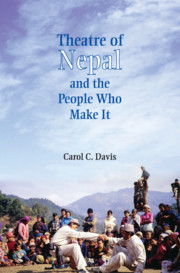Book contents
- Frontmatter
- Dedication
- Contents
- List of Figures
- Acknowledgements
- Prologue
- 1 From Darkness to Light: Antiquity through the Malla Golden Age
- 2 Ruthless Rulers: The Rise of the Shah and the Rana Takeover
- 3 The Drama of Nationalism: Sama Engaged
- 4 Modernism's Advance: Post-Sama Dramatists
- 5 The Pro-Democracy Movement: Ashesh Malla Takes to the Streets
- 6 Cultivating Theatre Aesthetics: Sunil Pokharel's Vision
- 7 Diaspora: Urban Theatre Outside the Capital
- 8 Legacy: Contemporary Theatre in the Kathmandu Valley
- Bibliography
- Index
1 - From Darkness to Light: Antiquity through the Malla Golden Age
Published online by Cambridge University Press: 26 April 2019
- Frontmatter
- Dedication
- Contents
- List of Figures
- Acknowledgements
- Prologue
- 1 From Darkness to Light: Antiquity through the Malla Golden Age
- 2 Ruthless Rulers: The Rise of the Shah and the Rana Takeover
- 3 The Drama of Nationalism: Sama Engaged
- 4 Modernism's Advance: Post-Sama Dramatists
- 5 The Pro-Democracy Movement: Ashesh Malla Takes to the Streets
- 6 Cultivating Theatre Aesthetics: Sunil Pokharel's Vision
- 7 Diaspora: Urban Theatre Outside the Capital
- 8 Legacy: Contemporary Theatre in the Kathmandu Valley
- Bibliography
- Index
Summary
Ever immersed in the study of Vedas and Sastras
Ever engaged in fire oblations
Ever devoted to the worship of gods and goddesses
I, now enter the playhouse
—Bhupatindra MallaNepal's theatre springs from a deep engagement with society. Today, as in ancient times, essential classical and native legends constitute the stories behind much of Nepal's theatre. Spiritually motivated ceremony offers the basis of some of the most theatrical of Nepal's performed culture. Such mythic and ritualistic foundations become springboards for creativity that free Nepali artists to express in their unique ways that which is quintessentially Nepal.
Sandwiched between its much larger and more powerful neighbours, China to the north and India to the south, east, and west, Nepal has long been a meeting ground for the peoples of central and Himalayan Asia who speak Tibeto-Burmese languages and the Aryan peoples of the southern plains who speak Indo-European languages. These disparate cultures have influenced all spheres of Nepali life, just as Nepal has conveyed its culture across the Himalayas. A history of invasions, warfare, conquest, and despotism has combined with rugged, isolating geography, to make Nepal home to peoples of widely varying ethnicity, language, and religious belief and artistic practice.
The Himalayan region that is now Nepal may have been inhabited for hundreds of thousands of years, as evidenced by Puranic stories and Paleolithic artifacts (Ram Nivas Pande, 1997: 118; Shiva Raj Shrestha, 2001: 5). Paleolithic tools unearthed in the Kathmandu Valley near Budhanilkantha attest to human presence there 300,000 to 40,000 years BP (‘before present’) (Shiva Raj Shrestha, 2001: 5). Weapons found give evidence of Neolithic groups dwelling there at least 9, 000 years ago (Corvinus, 2007). Little remains to suggest the artistic and religious expression of these Stone Age residents, although the oldest religion of the Kathmandu Valley seems to be related to pre-Aryan animistic, solar, and lunar cults (Regmi, 1960: 11; Shaha, 1992: 30). Ancient and early medieval history of Nepal is impossible to pin down with guaranteed certainty, even with the advent of written records, because sources tend to be literary rather than historical works primarily. Various chroniclers use different names for rulers and overlap dynasties, making absolute timelines impossible to ascertain, even for scholars of historical materials.
- Type
- Chapter
- Information
- Theatre of Nepal and the People Who Make It , pp. 1 - 15Publisher: Cambridge University PressPrint publication year: 2019



